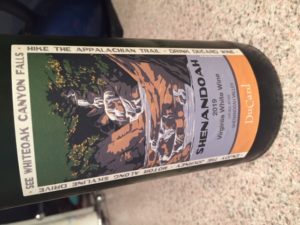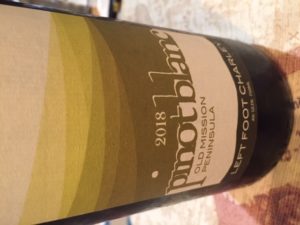Here in Central Virginia, we’ve gone from a serious (and damaging) frost last Sunday night, to temps in the upper ’80s by the end of the week, so a big transition from drinking reds to whites.
The first of these Wines of the Week is DuCard (Madison Co., VA)’s commemorative white wine “Shenandoah”, in tribute to the White Oak Canyon Art Deco-style poster sold in the Shenandoah National Park. Proprietor Scott Elliff tracked down the artist (living on his own island off the Alaskan coast) and got his permission to re-use the poster on the label of this wine, a portion of which will go to the Shenandoah National Park (DuCard is close to White Oak Canyon, a popular hiking spot, and backs up to the Park).
The Shenandoah commemorative white wine 2019 is 100% Traminette, grown in the Shenandoah Valley. The aroma is richly aromatic like this grape’s vinifera parent, Gewurztraminer; you think the wine will be thickly sweet. Even though it is 2.6% residual sugar, the acidity (much higher than in Gewurztraminer) makes this a well-balanced food wine (it drinks to me like the R.S. is only 0.5%), ideal with spicy foods or ripe cheese. The tropical fruit flavors are balanced with fresh acidity, and make this a fun and versatile wine. You could find yourself gulping it easily. Frankly, this is about the best Traminette table wine I’ve tasted.
The second wine of the week is the Left Foot Charley Pinot Blanc 2018, Old Mission Peninsula, MI. Proprietor and winemaker Brian Ulbrich stresses that the star here is the appellation (Old Mission Peninsula in northwest Michigan), as well as the four separate (1-acre) vineyards that provided the fruit: Prairie School, Seventh Hill, Shangri-La Too, and Mary Lyon’s.
Brian says that the “sandy loam soils and cool growing season release an aromatic presence not typically found in the white Pinot,” and I agree. I also like to see a Pinot Blanc with no oak and an alcohol around 12% (this is 12.1%).
This is a classic, elegant, understated Pinot Blanc, with lively mineral and lemon/lime notes on the nose. Understated but fresh and lightly lemon on the palate, the acidity is vibrant but not heavy-handed, and the fresh minerality lingers, making you think that the four vineyards and their subtleties are the real star here, not the grape. Just coming into its own, drink with shellfish or goat cheese appetizers during the hot months to come. Finished with a Stelvin cap, this could actually age for another year or two and hold up.


